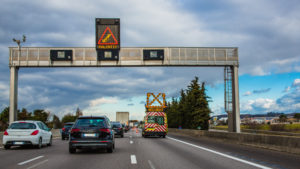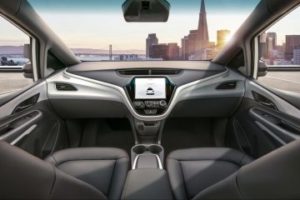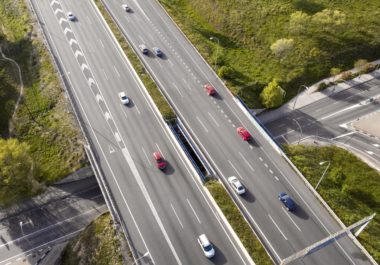V2X & C-V2X Technologies
The V2X & C-ITS technologies are a set of standards aimed at making new-generation vehicles interoperable and cyber-secure by equipping them with the capacity to interact with their environments (V2X = Vehicle to Everything).
In this multi-faceted ecosystem, connected vehicles communicate bidirectionally with other connected vehicles, with road infrastructures such as traffic lights or parking lots, with pedestrians equipped with smartphones or with data centers via cellular networks, to name but a few examples.
Because it is universal and scalable, this technology can be used concurrently for multiple purposes: giving priority to public transport and priority vehicles, helping autonomous shuttles at passing points, sending incident notices to connected vehicles, making roadworks safer, etc.
The technology uses a short-range wireless signal to communicate with compatible systems. The signal is transmitted over a dedicated, protected radio band using either ITS-G5 point-to-point radio (5.8 GHz) or cellular connectivity (3G/4G/5G). It is resistant to interference and adverse weather conditions.
The standards for V2X exchanges are set at the European level. Many vehicle brands and models are already using this form of technology, also known as Car-to-X: BMW, PSA, Ford, Renault, Audi, Cadillac, Volkswagen, Toyota, Lexus, and others.
V2X technology is particularly used in automated vehicles, which analyze the environment in real time to detect risks and act accordingly. Technology gives them a wider range and more information so that they can make the most appropriate decisions in the face of the dangers they encounter. V2X systems also transcend the harsh weather conditions that often affect these vehicles, thus offering an additional benefit.
The benefits of V2X
Improving road safety
 The Road-Side Unit sends hazard warnings to the vehicle in less than one second (e.g. traffic jams, accidents, misinterpretations). The vehicles communicate directly with each other and better anticipate collisions.
The Road-Side Unit sends hazard warnings to the vehicle in less than one second (e.g. traffic jams, accidents, misinterpretations). The vehicles communicate directly with each other and better anticipate collisions.
Contributing to the simple and rapid deployment of the autonomous vehicle
 The autonomous vehicle is myopic beyond 100 m and cannot interpret dynamic signaling.
The autonomous vehicle is myopic beyond 100 m and cannot interpret dynamic signaling.
With V2X, the road infrastructure sends out reports on the condition of the signaling points (intersections, tolls, speed limits, work), digitally and in real time.
Reducing traffic and pollution

Thanks to this technology, the vehicles in interaction with the road infrastructures make it possible to automatically regulate the speed on the roads. Reduced speed enables smoother circulation and a reduction in pollution.
Securing and optimizing all forms of mobility

Prioritizing public transport, and taking into account the presence of pedestrians and cyclists at intersections, V2X solutions take into account all forms of mobility.







